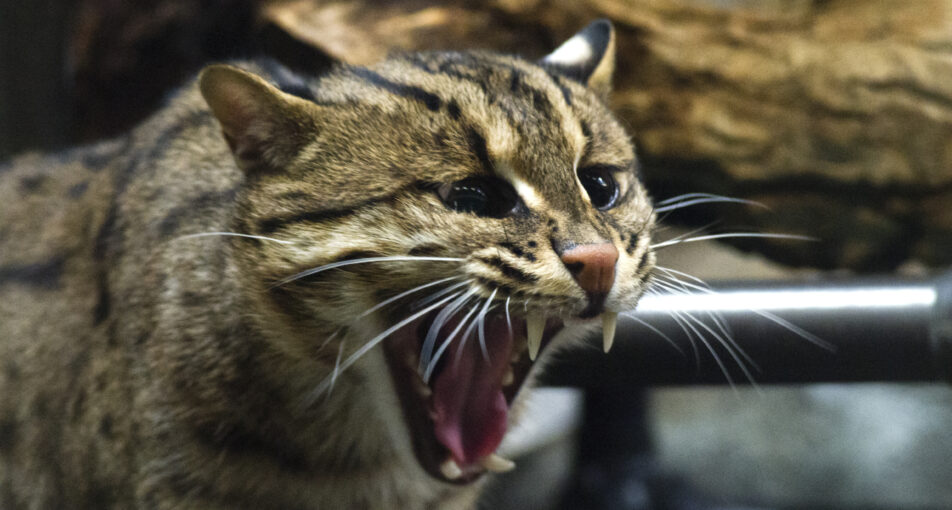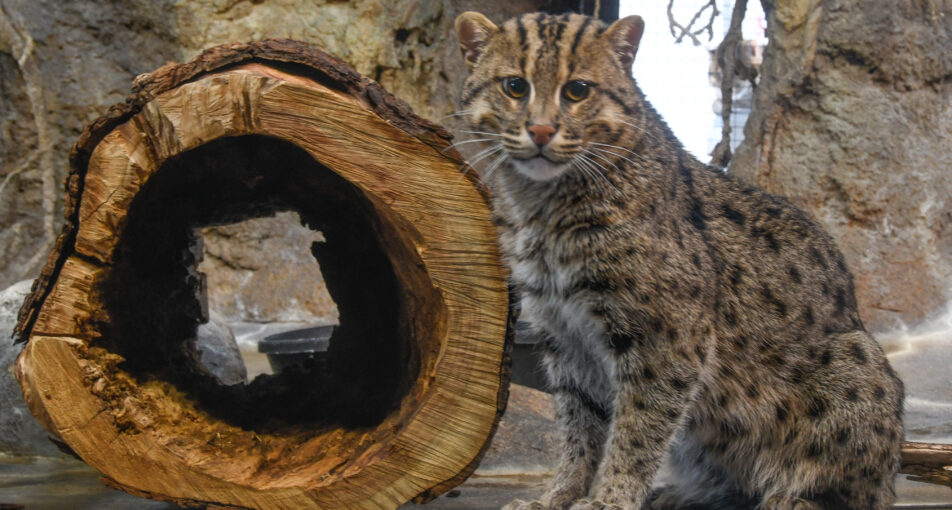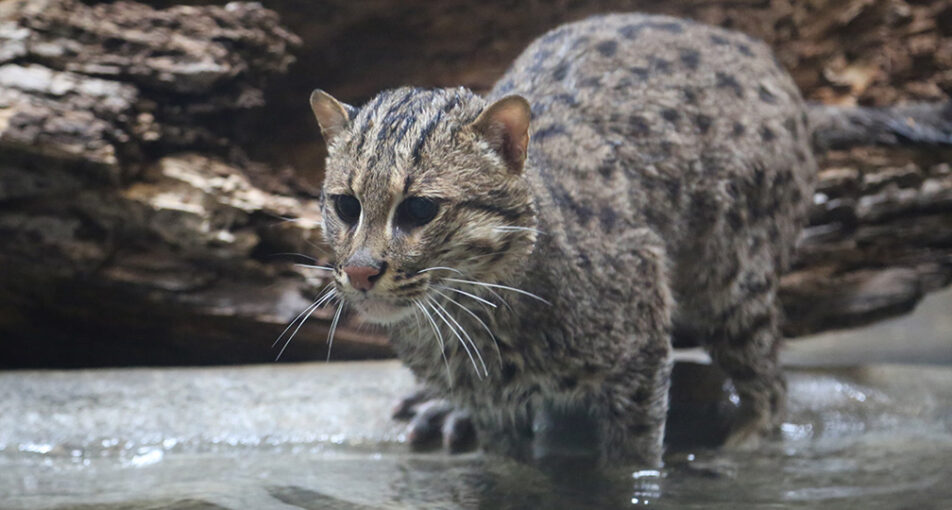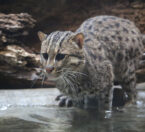Fishing cats live up to their name. Fishing cats are great swimmers and have adapted to hunting in marshy areas of Southeast Asia. They have been observed in the wild “fishing” at the edges of bodies of water. They appear to scoop their prey from the depths of the water with their partially webbed paws, and have also been observed playing with fish in shallow water. Fishing cats are best described as piscivores-predominately feeding on fish and shellfish.
Classification
| CLASS: | Mammalia |
| ORDER: | Carnivora |
| FAMILY: | Felidae |
| GENUS: | Prionailurus |
| SPECIES: | viverrinus |
Habitat & Range
Fishing cats are found in scattered areas throughout Asia. They inhabit the peninsular region of India, and areas of Southeast Asia including, Sri Lanka, Malaysia, Sumatra, Thailand, Java, and Pakistan.
Fishing cats live primarily in wetland areas, both marshes and swamps. These cats can be found in heavily forested regions adjacent to rivers or near jungles. They can also be found in scrub areas, reed beds, tidal creek, and mangrove areas. In the Nepalese lowlands some individual fishing cats spend a lot of time in dense grasslands well away from water.
Location


Adaptations
- Possibly the most obvious and striking adaptation of fishing cats compared to other cats, is the webbing between their toes and their behavior in and around water. Fishing cats are great swimmers and have adapted to hunting in marshy areas of Southeast Asia. They have been observed in the wild “fishing” at the edges of bodies of water. They appear to scoop their prey from the depths of the water with their partially webbed paws, and have also been observed playing with fish in shallow water. In captivity they have been observed to engage in washing behavior -taking flesh of other prey and dropping it in the water, retrieving it , and then eating it. They are also strong swimmers and will swim and dive for their prey. By tapping their paws on the surface of the water, they trick fish into thinking the water ripples are from an insect. When the fish is close enough, the cat dives in after it.
- Fishing cat’s fur has two layers: one layer is very short and dense to keep the cat’s skin warm and dry during time spent in the water; longer hairs, called guard hairs, give the cat its color pattern, which is great for camouflage.
- Like many smaller felines, fishing cats communicate with hisses, guttural growls, and even a low, demanding meow. Males and females make sounds called “chittering” as part of their courtship.
- Kittens learn to fish by watching their mother.
Physical Description
- Fishing cats are considered one of the largest of the lesser cats. Adults can weigh 13 to 26 lb (6-12 kg) and measure 2-3 feet long (0.6-1 m).
- Fishing cats are powerfully built with short limbs and a stocky body.
- They have a long head and a short tail that is roughly one-third the length of their body.
- Their fur is coarse and brownish gray in color with distinctive dark markings, which are a combination of both spots and stripes. These spots are arranged longitudinally across the body. Six to eight dark lines run from above the eyes between the ears over the crown to the nape of the neck. These lines gradually break up into shorter bars and spots on the shoulders. The fur on the underside is longer and spotted, and the tail is ringed with 5-6 black rings; tail tip is black.
- The ears are small and set low on the sides of the head. The backs of the ears are dark and have a central white spot. The face has two dark stripes extending across the cheeks from the eye to below the ear.
- The paws have moderately well-developed webs, and the claws extend past the claw sheaths when retracted.
Diet
What Does It Eat?
In the wild:
Fishing cats are best described as piscivores-predominately feeding on fish and shellfish. However, fishing cats’ teeth are not specially modified for catching fish and its diet probably includes any small to medium-sized vertebrate it can catch. These cats are known to have killed frogs, snakes, and insects; also rodents, small civets, fawns, small pigs, coots, ducks, sandpipers, and a variety of domestic animals such as goats, calves, poultry and even dogs have been prey of fishing cats. At times they have been observed to be feeding on dead cows, so are thought to also eat some carrion.
At the zoo:
At Denver Zoo the fishing cats are fed primarily fish (salmon, cod, herring, capelin, smelt, crayfish). At the zoo they are often fed live tilapia to allow the cats to hone their hunting and fishing skills. They also receive a small amount of various meat/prey items such as chicken, rabbit and rib bones.
What Eats It?
Fishing cats do not have any documented predators other than man.
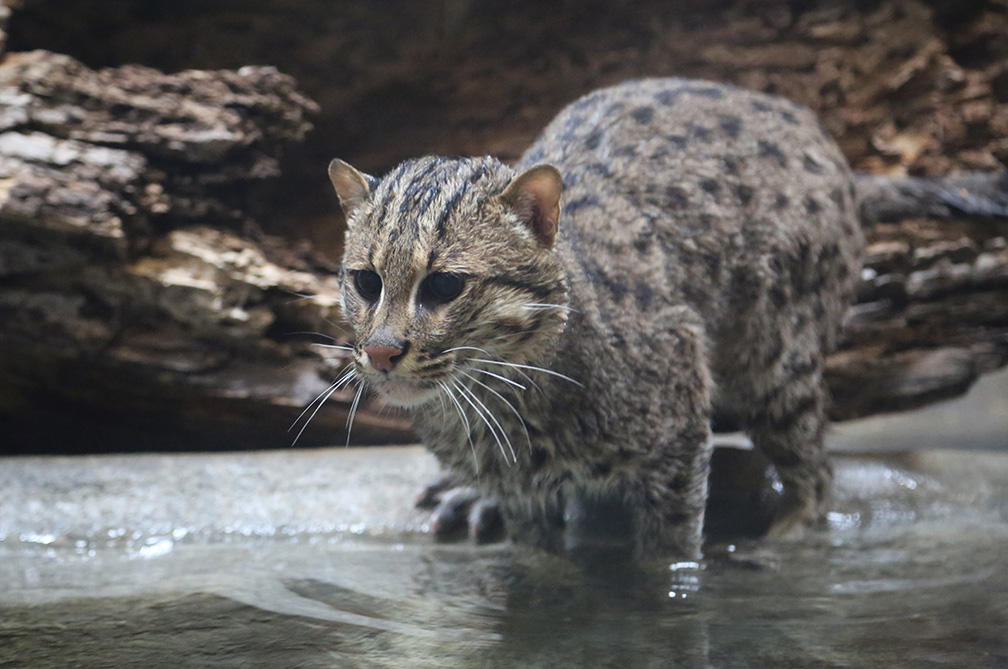
Social Organization
These animals are thought to be primarily nocturnal and solitary, with males having a territorial range of 16-22 km and females 4-6 km and mark their territory with their strong-smelling urine. However, little is really known of their behavior in the wild.
Life Cycle
Fishing cats mate in January and February. A male and a female make a sound called chittering as part of their courtship, with the female signaling her willingness to breed and the male communicating submissiveness. Birthing dens are often found in dense patches of reeds. Gestation lasts about 63-70 days and litter size varies from 1-4 with an average litter of 2 kittens. In the wild females raise their young without help from the male; he doesn’t stay around once breeding is over. But males in captivity have been observed helping females care for and rear the young. The kittens weigh 100-173 grams at birth and will gain 11 grams per day. On the 16th day their eyes open. The kittens take meat around the 53rd day and are weaned at 4-6 months of age. At 8-9 months the young reach adult size and are independent at 10 months, and probably reach sexual maturity soon after. Not much is known about the lifespan of fishing cats in the wild. Zoo records indicate they many live up to 12 years in human care.
